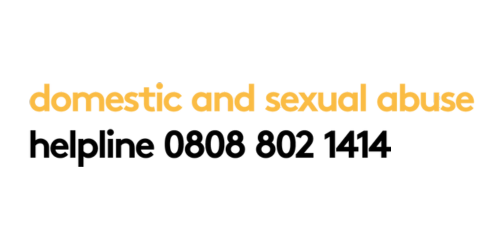Types of domestic abuse
The Domestic and Sexual Abuse Helpline provides information and signposting to those affected by Domestic and Sexual Abuse across Northern Ireland.
Call us now on 0808 802 1414
or email help@dsahelpline.org
Psychological abuse
Psychological abuse involves a person’s attempts to frighten, control, or isolate you.
Sexual abuse
Sexual abuse is abusive sexual behaviour by one person upon another. It is often perpetrated using force or by taking advantage.
Physical abuse
Physical abuse is any intentional act causing injury or trauma to another person by way of bodily contact.
Coercive control
Coercive control is an act or patterns of assault, threats, humiliation and intimidation or other abuse that is used to harm, punish, or frighten their victim.
Financial abuse
Financial abuse can take the form of fraud, theft or using of a vulnerable persons property without their permission. Click to read more.
Technological abuse
Technological abuse is using modern technology to perpetrators ways to stalk, isolate and control.
Why don’t they leave
What is abuse?
Everyone has arguments, and everyone disagrees with their partners, family members and others close to them from time to time. And we all do things at times that we regret, and which cause unhappiness to those we care about. But if this begins to form a consistent pattern, then it is an indication of domestic violence and abuse.
The definition of Domestic Violence and Abuse is: ‘threatening, controlling, coercive behaviour, violence or abuse (psychological, virtual, physical, verbal, sexual, financial or emotional) inflicted on anyone (irrespective of age, ethnicity, religion, gender, gender identity, sexual orientation or any form of disability) by a current or former intimate partner or family member’.
The definition of Sexual Violence and Abuse is: ‘any behaviour (physical, psychological, verbal, virtual/online) perceived to be of a sexual nature which is controlling, coercive, exploitative, harmful, or unwanted that is inflicted on anyone (irrespective of age, ethnicity, religion, gender, gender identity, sexual orientation or any form of disability).’
Leaving the Situation
By understanding the many barriers that stand in the way of a person leaving an abusive relationship – be it psychological, emotional, financial or physical threats – we can begin to support and empowers abuse victims to make the best decision for them while holding abusers solely accountable for their behaviour. Here are just a few of the reasons that prevent a person from leaving:
Danger and fear
One of the most important reasons people do not leave is because it can be incredibly dangerous. The fear that an abuse victim can feel is very real – there is a huge rise in the likelihood of violence after separation.
Isolation
Domestic abuse often relies on isolating the victim: the perpetrator works to weaken connections with family and friends, making it extremely difficult to seek support. Perpetrators will often try and reduce a person’s contact with the outside world to prevent them from recognising that the behaviour is abusive and wrong. Isolation leads the person to become extremely dependent on their controlling partner.
Shame, embarrassment or denial
Perpetrators are often well respected or liked in their communities because they are charming and manipulative. This prevents people recognising the abuse and isolates the person further. The perpetrator often minimises, denies, or blames the abuse on the person. The person may be ashamed or make excuses to themselves and others to cover up the abuse.
Trauma and low confidence
Imagine being told every day that you are worthless and the impact that this has on your self-esteem. People in an abusive relationship have very limited freedom to make decisions, they are often traumatised, regularly told ‘you couldn’t manage on your own, you need me’. Fear is constant and they live in a world of everyday terror.
Practical reasons
Abusers often control every aspect of their victim’s life – making it impossible to have a job or financial independence. By controlling access to money people are left unable to support themselves or their children. They may fear having their children taken away or, if there is an insecure immigration status, may fear being deported.
Asking for help is not easy. Misunderstandings about domestic abuse often prevents professionals from knowing what to do, how to talk about it or where to direct people disclosing abuse.
Supporting a Victim
Leaving an environment where abuse is occurring or has occurred takes courage but support is available from seeking space in a pharmacy consulting room to make a private phone call to a free transportation system offered by Translink which can be arranged by the Domestic and Sexual Abuse Helpline.
There are a number of ways you can support a victim by offering them a safe space to confide in you or tell them you have concerns about their well being but most importantly listen and believe them. Trust what they say.
Opening up may be a very emotional and traumatic time for the individual. They may blame themselves. It is important you support them and reassure them that it is not their fault.
Encourage them to get support from the Domestic and Sexual Abuse Helpline and remind them there is a way out.
Reassure them they are doing the right thing and support them to ensure they are not alone.
Law & Legal
In this section, you can find out about the variety of legal options that are out there to help you (including the Domestic Violence Disclosure Scheme) and what the PSNI can do to help in cases of Domestic Abuse and Sexual Abuse.
Domestic Violence and Abuse is be defined as: ‘threatening, controlling, coercive behaviour, violence or abuse (psychological, virtual, physical, verbal, sexual, financial or emotional) inflicted on anyone (irrespective of age, ethnicity, religion, gender, gender identity, sexual orientation or any form of disability) by a current or former intimate partner or family member.’
